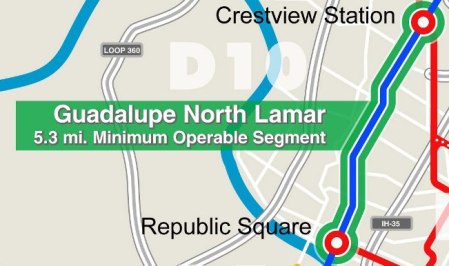
Ann Kitchen chairs City of Austin Mobility Committee meeting of June 14th. Photo: Sceenshot from ATXN video.
♦
By Lyndon Henry
The following comments were made during Citizen Communications to a public meeting of the City of Austin’s Mobility Committee on 14 June 2016. Lyndon Henry is a transportsation planning consultant, a former board member of Capital Metro, a technical consultant to the Light Rail Now Project, and a contributing editor to this website.
I urge you to include a measure for urban rail in the proposed $720 million “mobility” bond package now under consideration. I support the proposal for an affordable 5.3-mile light rail Minimum Operable Segment on North Lamar and Guadalupe from Crestview to downtown.
Currently 83% of the proposed $720 million package is devoted to road projects. Surely some of these road projects could be replaced with the $260 million to $400 million that would facilitate an urban rail project.

Proposed 5.3-mile light rail transit starter line Minimum Operable Segment in Guadaluoe-Lamar corridor. Graphic: CACDC.
It’s absurd that the $720 million bond package you’re considering could be labeled a “mobility” package despite NO major initiative for transit, let alone urban rail, which has been studied and affirmed as a necessity for decades. This bond proposal stands in contradiction to the decades of official “green” rhetoric and policy initiatives such as Envision Central Texas and Imagine Austin that have verbally embraced public transportation and “high-capacity transit” as key “alternative mobility” measures necessary to “keep Austin moving”.
This road-focused $720 million package tries to address congestion by increasing “throughput” of vehicles. Unfortunately, experience and evidence suggest that this is a losing approach — trying to tweak more capacity to squeeze through more cars typically just induces more traffic. Furthermore, this influx of ever-growing vehicle traffic imposes more stress on congested areas such as Austin’s core.

Lyndon Henry presenting comments to City of Austin Mobility Committee on June 14th. Photo: Screenshot from ATXN video.
In contrast, this light rail plan (and future expansions throughout Austin) removes traffic from roadways by attracting motorists to the transit service, adding the equivalent of four lanes of extra peak capacity to this corridor. Can the same be said for the current $720 million road-focused bond plan?
I suggest that urban rail — providing highly attractive rail transit service on its own dedicated tracks — makes far more sense as a solution for alleviating mobility congestion, than simply trying to squeeze more traffic onto the city’s crowded streets, roads, and parking spaces.
I’ve heard the argument that urban rail is “not ready” to be offered as a bond measure. Yet polls and other evidence indicate resounding support for public transit and urban rail, and the Austin community has gone through years of repeated outreach exercises familiarizing them with the technology and the issues. The public seems more ready than ever to support rail; it’s Austin’s civic leadership that seems to have cold feet.
Finally, whatever bond package you choose, I urge you to unbundle the roads bonds from the small proportion of bicycle and pedestrian bonds. This would allow the community at least to consider these alternative mobility elements separately. ■
[

